Results 7,061 to 7,070 of 12089
Thread: Anandtech News
-
06-06-17, 10:16 AM #7061
Anandtech: ASUS Unveils Three Strix Gaming Monitors: FreeSync & High Refresh Rates
Hot on the heels of the Swift PG35VQ announcement, ASUS has unveiled three new Strix-branded gaming monitors that will feature AMD’s FreeSync technology. While the first Strix model was unveiled back at CES 2017 - the Strix XG27VQ - it was a one-off until the announcement of these newest models. Clearly, ASUS intends to have a gaming monitor lineup that consists of both the Strix and Swift series.
Starting off from largest to smallest, we have the Strix XG32V. This model has a 31.5-inch IPS panel with a WQHD resolution of 2560 × 1440 and an 1800R curve that should help provide a wider field of view. We don't have a ton of other technical details, we do know that this model can handle refresh rates of up to 144Hz and it supports FreeSync. It will be interesting to see what the actual FreeSync range actually is.
For connectivity, there are two DisplayPort 1.2 inputs, one HDMI 2.0 input, and an undisclosed amount of USB 3.0 ports. Like on many of their other new gaming-oriented monitors, ASUS has added Aura Sync lighting to the XG32V. This not only means there will be an ROG logo that shines down onto the desk, but a back panel that features RGB LEDs and that can be synchronized with other Aura Sync-enabled PC components and peripherals.
Moving on to the next monitor, the Strix XG27V is a more value-minded model that shares the 1800R curvature of the XG32GV, but shrinks the panel down to 27 inches and the resolution to 1920 x 1080. Thankfully, this model can handle refresh rates of up to 144Hz and it also supports FreeSync.
While the XG27V has onboard Aura RGB lighting, it doesn't have Aura Sync, so it cannot synchronize with other Aura-compatible components and peripherals. Although specifics are lacking, connectivity is the form of a DisplayPort input, an HDMI input, and DVI-D port.
While the Strix XG258 might be the smallest of the bunch, it has an ace up its sleeve. This 24.5-inch display features a 1920 x 1080, which is pretty conventional, but it supports a maximum refresh rate of up to 240Hz. According to ASUS, this means that the delay between new frames is just 4.2 ms, compared to 6.9 ms on a 144Hz gaming monitor.
Much like the XG27V, this model has onboard Aura RGB lighting, but it doesn't have Aura Sync, so it cannot synchronize with other Aura-compatible components and peripherals. For connectivity, there are two DisplayPort 1.2 and two HDMI inputs, one of which is HDMI 2.0.
Although we have no pricing details, all of these new Strix gaming monitors will be available starting in Q3.
More...
-
06-06-17, 10:16 AM #7062
Anandtech: The HTC U11 Giveaway: Win a Launch-Day Smartphone
A couple of weeks back, HTC announced their new flagship smartphone, the HTC U11. The latest in HTC’s now considerable history of flagship phones, the U11 bumps HTC up to Qualcomm’s latest Snapdragon 835 SoC while also going in a new direction for the company in terms of aesthetics, and even squeezing in a new input feature.
The HTC U11 is launching here in the United States on June 9th, so to celebrate it’s launch and HTC's final two Meet U demo events, HTC is giving us a phone to give away to our US readers.
HTC U11 Overview
Quickly recapping the new phone, the headline feature for the HTC U11 is its new method of interaction: Squeezing. If you’ve encountered any of the marketing material on the device, it’s all about the squeeze. HTC’s new philosophy is that smartphones are stagnating: every generation is just a spec update to the previous model, and the only thing that drives the industry is related to new interaction methods and ways of streamlining the use of a device. Hence the squeeze: by holding the U11 naturally and squeezing between the thumb and the other side of the hand, the squeeze action will do a number of things.
Under the hood, the U11 is backed by a Qualcomm Snapdragon 835 SoC and paired with 4GB of LPDDR4 RAM and 64GB of storage. HTC says it's using UFS NAND, although the company isn’t stating if it’s UFS 2.0 or UFS 2.1. The phone comes with a 5.5-inch QHD (2560x1440) SLCD5 IPS display, and HTC is color calibrating each phone at the factory. Meanwhile the rear camera is a 12MP UltraPixel 3, which offers OIS, an f/1.7 lens assembly, and 1.4 micron pixels.HTC U11 HTC U11 SoC Qualcomm Snapdragon 835
4x Kryo 280 Perf @ 2.45 GHz
4x Kryo 280 Eff @ 1.90 GHz
Adreno 540 @ 653 MHzDisplay 5.5-inch 2560x1440 SLCD5 Dimensions 153.9 x 75.9 x 7.9 mm
169 gramsWaterproof Yes (IP67) RAM 4 GB NAND 64 GB UFS MicroSD Yes Rear Camera 12MP "UltraPixel 3" w/ OIS, f/1.7, 1.4µm pixels Front Camera 16MP Battery 3000 mAh
non-replaceableModem Qualcomm X16 (Integrated)
2G / 3G / 4G LTELTE Bands 1, 3, 4, 5, 7, 8, 12, 17, 20, 32
38, 39, 40, 41SIM Size NanoSIM Wireless 802.11ac,
BT 4.2, NFC, GPS/GLONASS/BDSConnectivity USB 3.0 (5 Gbps), Type-C, Quick Charge 3.0 Launch OS Android 7.1 with HTC Sense
The big aesthetic change for the U11 is its "liquid surface design," which mimics the visual properties of a liquid, by covering both the front and back with Gorilla Glass 5. The manufacturing process that adds color into the 3D glass is called "Spectrum Hybrid Deposition," and in the devices we saw it gave them a very shiny and metallic look (it also attracts fingerprints very easily). Presumably for that reason, a clear case is provided in the box.
The Giveaway
As HTC isn’t able to offer an unlocked phone that works with all 4 major US carriers, instead we'll be giving the winner the model and color of their choosing. That’s either the unlocked version, which works on AT&T, Verizon, T-Mobile, or the Sprint locked version. The unlocked version is available in blue, black, or silver, while the Sprint version is only available in blue or black.
Finally, please note that like our other giveaways, this giveaway is only open to US residents. The giveaway will run from now to 2pm ET on June 9th, the day of the HTC U11 launch. For the full details, please see the terms & conditions on the Gleam widget.
Good luck to everyone!
The HTC U11 Smartphone Giveaway
More...
-
06-06-17, 06:27 PM #7063
Anandtech: Apple Refreshes iPad Pro Lineup: A10X Fusion SoC for 10.5-inch, 12.9-inch
In addition to showing off its latest OS and software updates, Apple made several hardware announcements at WWDC 2017, including a refreshed iPad Pro lineup. The smaller of the two Pros ditches the 9.7-inch screen, which dates all the way back to the original iPad, for a 10.5-inch panel that fits into a chassis only 10.6mm (0.42”) taller and 4.6mm (0.18”) wider than the outgoing model thanks to smaller bezels. The expanded all-aluminum chassis increases weight by 7% or 32 grams, just enough to notice if you’re familiar with one of the recent models. The larger 12.9-inch Pro—first released at the end of 2015—finally gets some attention too. After missing out on the new hardware introduced with the 9.7-inch iPad Pro last year, the big Pro has been brought up to parity with the new 10.5-inch Pro.
Both the 10.5-inch and 12.9-inch LCD panels are new for this generation and share the same specifications. The 264ppi panels can display more vivid and lifelike colors by extending color coverage well beyond the sRGB standard with DCI-P3 gamut support. And because iOS supports ColorSync, Apple’s color management system, the Pros’ wide-gamut panels maintain color accuracy by respecting the source material’s target gamut (no overly-vivid, neon colors when viewing sRGB content, for example).
Both models also support Apple’s True Tone display technology that adjusts the display’s white point based on ambient light. The idea here is for the screen to replicate what happens to a white sheet of paper under different lighting conditions. If you read a printed book in an incandescent bulb’s warm light, the page will reflect that light and appear warmer, more yellow. True Tone does the same thing, reducing the LCD’s blue output and shifting the white point to appear warmer. Matching the display’s output to its environment is supposed to reduce eye strain, but True Tone can be disabled if it’s not to your liking.
Apple claims both displays can hit 600 nits peak brightness, which is impressive for tablets. We previously measured the 9.7-inch iPad Pro at 520 nits and the 12.9-inch iPad Pro at 427 nits, so this should bring a noticeable visibility improvement in bright light, especially for the big Pro. Both panels are also fully laminated to the cover glass and use an improved antireflective coating to further improve visibility and diminish eye strain by reducing screen reflections. The improved coating was first used on the 9.7-inch iPad Pro, and after comparing it side by side with the iPad Air 2, I was really impressed with how well it works.
Before we move on to other hardware, it’s worth mentioning that Apple is using an adaptive refresh rate on the new Pros, a technology it calls ProMotion. The standard refresh rate doubles from 60Hz to 120Hz, which should help UI animations appear more fluid. It also reduces the Apple Pencil’s latency, making inking smoother with less lag. Driving a panel at 120Hz increases power consumption (panel and SoC), however. To help reduce the impact on battery life, the refresh rate is adjusted down to 24Hz or 48Hz when displaying content that would not benefit from the faster refresh, such as reading an ebook or Web page, for example.Apple iPad Pro Comparison iPad Pro 10.5"
(2017)iPad Pro 12.9"
(2017)iPad Pro 9.7"
(2016)iPad Pro 12.9"
(2015)SoC Apple A10X Fusion
3x Apple performance cores
3x Apple efficiency cores
12 core GPUApple A9X
2x Apple Twister @ ~2.2GHz
PowerVR 12 Cluster Series7XTDisplay 10.5-inch 2224x1668 IPS LCD
DCI-P3, 120Hz12.9-inch 2732x2048 IPS LCD
DCI-P3, 120Hz9.7-inch 2048x1536 IPS LCD
DCI-P312.9-inch 2732x2048 IPS LCD
sRGBDimensions 250.6 x 174.1 x 6.1 mm
469 / 477 grams (WiFi / LTE)305.7 x 220.6 x 6.9 mm
677 / 692 grams (WiFi / LTE)240.0 x 169.5 x 6.1 mm
437 / 444 grams (WiFi / LTE)305.7 x 220.6 x 6.9 mm
713 / 723 grams (WiFi / LTE)RAM ? 4GB LPDDR4 2GB LPDDR4 4GB LPDDR4 NAND All: 64GB / 256GB / 512 GB All:
32GB / 128GB / 256GBWiFi:
32GB / 128GB / 256GB
WiFi + Cellular:
128GB / 256GBBattery 30.4 Wh 41.0 Wh 27.5 Wh 38.5 Wh Front Camera 7MP, f/2.2, Auto HDR, Wide Color Gamut, Retina Flash 5MP, f/2.2 1.2MP, f/2.2 Rear Camera 12MP, 1.22µm pixels, f/1.8, PDAF, OIS, Auto HDR, Wide Color Gamut, True Tone Quad-LED flash 12MP, 1.22µm pixels, f/2.2, True Tone LED flash 8MP, 1.1µm pixels, f/2.4 Cellular 2G / 3G / 4G LTE (Category 9) 2G / 3G / 4G LTE (Category 4) SIM Size NanoSIM NanoSIM Wireless 802.11a/b/g/n/ac 2x2 MIMO, BT 4.2 LE, GPS/GLONASS 802.11a/b/g/n/ac 2x2 MIMO, BT 4.2 LE, GPS/GLONASS Connectivity Apple Lightning, 3.5mm headphone, Apple Smart Connector Apple Lightning, 3.5mm headphone, Apple Smart Connector Launch OS iOS 10 iOS 9 Launch Price Wi-Fi:
$649 (64GB)
$749 (256GB)
$949 (512GB)
Wi-Fi + LTE:
$779 (64GB)
$879 (256GB)
$1079 (512GB)Wi-Fi:
$799 (64GB)
$899 (256GB)
$1099 (512GB)
Wi-Fi + LTE:
$929 (64GB)
$1029 (256GB)
$1229 (512GB)Wi-Fi:
$599 (32GB)
$749 (128GB)
$899 (256GB)Wi-Fi:
$799 (32GB)
$949 (128GB)
$1079 (256GB LTE)
Under the display is an Apple A10X Fusion SoC that comes with additional CPU and GPU cores compared to the A10 Fusion SoC used in the iPhone 7. Instead of 2 performance CPU cores and 2 efficiency cores, the A10X Fusion uses 3 of each. It also doubles the number of GPU cores, which makes sense considering it needs to drive a lot more pixels at a higher refresh rate. Apple claims a 30% improvement in CPU performance and a 40% faster GPU compared to the Apple A9X SoC used in the previous generation.
It’s still not clear how much RAM the new Pros have. It’s probably safe to assume that the 12.9-inch model still comes with 4GB, but does the 10.5-inch model stick with 2GB like the 9.7-inch Pro? Considering all of the new multitasking features and visual elements in iOS 10/11, a bump to 4GB is certainly justified, although, Apple tends to be frugal with RAM.
Internal storage capacity doubles, with the least-expensive models packing 64GB of NAND. The next two storage tiers jump to 256GB and 512GB, which makes these iPads a bit more competitive with other ultraportable devices targeted at professionals. The extra space is also essential if you plan to use an iPad for less ‘Pro’ purposes such as watching TV shows or movies, which eat up space quickly.
The cameras on iPads have always seemed like an afterthought, with Apple using iPhone leftovers a generation or two old. Because tablets typically are not the first device people reach for when shooting photos and video, camera hardware is an obvious place to save money. This is not the case with the new iPad Pros, however, which receive the biggest camera upgrade since Apple first added cameras to the iPad 2. Both the front and rear camera modules are shared with the iPhone 7. That means a 7MP FaceTime HD camera on the front that supports automatic HDR imaging, wide color gamut photos, and 1080p video recording. You can also use the iPad’s display as a flash. Around back is a 12MP camera with 1.22µm pixels, OIS, Focus Pixels (PDAF), a 6-element lens array with a large f/1.8 aperture, and a quad-LED True Tone flash. It also supports automatic HDR imaging and wide color gamut photos and uses OIS and EIS for stabilizing video.
The new Pros come with 802.11ac 2x2 MIMO Wi-Fi that offers a peak theoretical throughput of 866Mbps. Like previous iPads, there’s Wi-Fi only and Wi-Fi + LTE cellular variants. The cellular-enabled models get a new Category 9 LTE modem with up to 450Mbps on the downlink. There’s also support for 25 LTE bands and an embedded Apple SIM.
The new iPad Pros look like, well…iPads. The aluminum shell is visually indistinguishable from earlier models and still has a Lightning connector on the bottom, a 3.5mm headphone jack and power button in opposite corners at the top, volume buttons on one side, and an Apple Smart Connector on the other. The proprietary Smart Connector transfers both data and power to optional peripherals such as external keyboards. There are also 4 speakers—2 on the top and 2 on the bottom—that provide better sound than the mono speakers on older iPads and are less prone to being covered by your hands when holding it in landscape mode.
The 12.9-inch Pro looks the same as the previous version from the front, while the 10.5-inch Pro has noticeably narrower bezels along the sides of the display. The physical home button includes an upgraded Touch ID sensor (same as iPhone 7) that’s 2x faster.
Both the 10.5-inch and 12.9-inch iPad Pros are available for preorder and will begin shipping mid June. Unlike the iPhone 7, Apple is not offering any new color choices for the iPads, so we get the familiar Silver, Space Gray, Gold, and Rose Gold. The Apple Pencil can be purchased separately for $99, and Apple offers its Smart Keyboard for $159 and $169 for 10.5- and 12.9-inch models, respectively.
More...
-
06-07-17, 09:34 AM #7064
Anandtech: ASRock Demos X399 ‘ThreadRipper’ Motherboards: M.2, U.2, 10 GbE, & More
At Computex last week, ASRock demonstrated two motherboards designed for AMD’s upcoming ThreadRipper HEDT processors. The new platforms are for high-end workstations and designed to support up to four graphics cards though the 60 PCIe lanes from the CPU, over a dozen of storage devices and up to eight DIMMs. To a large degree, ASRock’s motherboards reflect overall positioning of the AMD X399 “ThreadRipper” platform as a premium high-end desktop play, and what to generally expect from makers of mainboards here.
ASRock plans to offer two motherboards for AMD’s ThreadRipper CPUs: the X399 Professional Gaming and the X399 Taichi. The mainboards are based on the same PCB (and the same AMD X399 chipset/socket), but have a slightly different feature set. The ThreadRipper motherboards that ASRock demonstrated at Computex featured an eight-phase digital CPU VRM, which is the feasible limit given the physical space available, but we have no idea the capabilities of the power delivery as of yet. ThreadRipper is meant to be a high performance, high power processor, so undoubtedly the motherboard vendors have built their boards to match. When it comes to the socket itself, it has 4094 pins and is very large (not surprising given its origin). We've seen the socket referred to as SP3r2 and TR4, although the official word from AMD is that it is the 'X399 platform'.
It will be interesting to see whether any motherboard maker manages to design a Mini-ITX mainboard for the ThreadRipper, but we will see. As we understand it, one of the problems with the socket, apart from the dimensions, is its cost to manufacturers that is prohibitively high at this time.
Both of the X399 motherboards from ASRock have eight DDR4 memory slots, but the manufacturer does not disclose speeds, ECC support and other details (although given previous discussions, we expect at least ECC and DDR4-2400). In fact, it does not even reveal the maximum amount of memory supported by the CPU. Though even if the company does know, it's almost certain that AMD wants to hold all of these cards close to their chest for future product announcements.
The X399 Professional Gaming physically has four PCIe 3.0 x16 slots (electrically set at two x16 and two x8) that can support up to four-way AMD CrossFireX or NVIDIA SLI multi-GPU configurations, as well as PCIe SSDs. In addition, there is a PCIe 3.0 x1 slot. As for storage options, ASRock has most configurations covered: the motherboard carries eight SATA ports, a U.2 connector, as well as three M.2 slots. To ensure that there is enough power for the latter, there is a 6-pin PCIe power connector right near the SATA ports. As for network connectivity, the motherboard features a 10 GbE port using Aquantia's AQC solution, two GbE headers (enabled by Intel controllers), as well as a 2x2 802.11 Wi-Fi module with Bluetooth. As for USB, there are 10 USB 3.0 ports in addition to two USB 3.1 ports (Type-A and Type-C) on the back panel. Finally, the X399 Professional Gaming has a 7.1 audio sub-system enhanced using Creative Labs’ SoundBlaster software.
It is worth nothing that we expect the X399 chipset to be as capable as the AM4 X370 platform, which means that some of the features on the motherboard are likely to have shared resources, meaning having one enabled will disable some others. AMD has engineered the CPU to have 60 PCIe lanes for storage and graphics, which will nominally mean most configurations will allow three GPUs (totalling 48 lanes) and three M.2 slots (totalling 12 lanes) although the 10GbE controller will require some lanes as well as the other Ethernet and perhaps a USB port controller or two. Until we see the chipset diagram, it will be hard to tell at this point.ASRock's X399 Professional Gaming and X399 Taichi for AMD ThreadRipper CPUs X399 Professional Gaming X399 Taichi CPU Support AMD ThreadRipper CPUs in LGA4094 form-factor Graphics 4 × PCIe 3.0 x16 (2 × x16, 2 × x8)
4-way AMD CrossFireX and NVIDIA SLI supportedChipset AMD X399 Memory Eight DDR4 DIMM slots Ethernet 1 × 10 GbE Aquantia AQtion AQC107
2 × Intel GbE controllers2 × Intel GbE controllers Storage 8 × SATA 6 Gbps
3 × M.2 (PCIe 3.0 x4 or SATA)
1 × U.2 (PCIe 3.0 x4)Audio Realtek ALC1220 (?)
7.1 channel audio with Creative Labs SoundBlaster Cinema 3 enhancementsRealtek ALC1220 (?)
7.1 channel audio with ASRock Purity Sound 4USB 8 × USB 3.0 Type-A
1 × USB 3.1 (Gen 2) Type-A
1 × USB 3.1 (Gen 2) Type-COther I/O Dual band 802.11ac Wi-Fi + Bluetooth 4.x, PS/2 Form-Factor ATX MSRP Expensive Less Expensive
The ASRock X399 Professional Gaming and the X399 Taichi will be available later this year when AMD releases its ThreadRipper CPUs. It goes without saying that the motherboards are not going to be cheap: they are not designed for general consumers and their server origin will have a direct impact on pricing.
Related Reading:
- AMD CPU Updates: 16 Core ThreadRipper w/64 PCIe Lanes This Summer, Epyc Launching June 20th
- AMD Announces Ryzen AGESA 1.0.0.6 Update: Enables Memory Clocks Up To DDR4-4000
- Computex 2017: AMD Press Event Live Blog
- ASRock Announces X299 Professional Gaming i9 with 3-Way Multi-GPU, 10Gb Ethernet, & Wi-Fi
- Intel Announces Skylake-X: Bringing 18-Core HCC Silicon to Consumers for $1999
- Intel Announces Basin Falls: The New High-End Desktop Platform and X299 Chipset
More...
-
06-08-17, 08:13 AM #7065
Anandtech: Enermax Launches MaxTytan: 80 Plus Titanium, Up to 1250 W, Integrated Powe
Enermax announced its new flagship lineup of power supplies at Computex. The new MaxTytan series is 80 Plus Titanium rated, while the top-end models also include an integrated power meter as well as a bundled RGB lighting controller. The new PSUs are set to be available late this summer.
The Enermax MaxTytan family will include four models speced for 750 W, 800 W, 1050 W and 1250 W output. All MaxTytan SKUs support the company’s DFR (dust free rotation) technology (requires manual activation on the entry-level models) and fanless operation at below 55% – 60% load. Meanwhile, the two 1 kW models feature Enermax’ Coolergenie device for system fan control and have an integrated power meter. It is not completely clear whether the power meter measures consumption of the PC or the amount of watts that the PSU consumes from the outlet, but at least it gives an idea about general power consumption (and given the 80 Plus Titanium rating, the difference between consumption of the PSU and the PC itself should not be too significant). Moreover, the MaxTytan series is the first 80 Plus Titanium consumer PSU family to support the feature anyway.
In order to get the “80 Plus Titanium” certificate, a PSU is mandated to be at least 94% efficient under a 20%, 50% and 100% load as well as at least 90% efficient under a 10% load. The latter requirement is exclusive to the 80 Plus Titanium spec and is not easy to support due to various reasons. According to Ecova Plug Load Solutions, there are 49 PSUs in the world that have the 80 Plus Titanium badge. Just for comparison, there are 481 models featuring the 80 Plus Platinum label.
The Enermax MaxTytan family of PSUs are compliant with the ATX 12V v2.4 and EPS (presumably v2.92) specifications and have two 4+4 CPU power connectors to handle dual-socket systems.
The MaxTytan feature a modular design and is equipped with individually sleeved cables, high quality capacitors rated to operate at high temperatures caused by loads of enthusiast-class PCs and so on. All the MaxTytan PSUs have enough auxiliary 8-pin PCIe connectors to power systems running two (or more) high-end graphics cards with two 8-pin PCIe power plugs. The PSUs also have multiple connectors for devices with SATA, Molex, and other power headers.
Enermax is set to kick off mass production of its MaxTytan PSUs in mid-June. Typically, devices like these hit the market about two months after the mass production starts, so expect MaxTytan to be available in mid-August. As for pricing, Enermax tells us that the entry-level model will retail for $210, whereas the top-of-the-range PSU with a power meter will cost $360.Enermax MaxTytan Titanium Series Output Specifications EMT750EWT EMT800EWT 1050 W 1250 W Rated Combined Rated Combined Rated Combined Rated Combined +3.3V 20 A 100 W 20 A 100 W ? ? ? ? +5V +12V 62.5 A 750 W 66.5 A 798 W 87.5 A 1050 W 104 A 1250 -12V 0.3 A 3.6 W 0.3 A 3.6 W 0.3 A 3.6 W 0.3 A 3.6 W +5Vsb 3 A 15 W 3 A 15 W 3 A 15 W 3 A 15 W Total Power 750 W 750 W 1050 W 1250 W Manual Link - - MSRP ~$200 $210 $299.99 $359.99
Related Reading:
- Enermax D.F. Vegas: Self-Cleaning Fans with LEDs
- Thermaltake Adds RGB Lighting to Toughpower Grand Gold PSUs
- Best PC Power Supplies: Holiday 2016
- Enermax Enters SFX Game with Revolution SFX PSUs
- Enermax SteelWing Small Form Factor PC Chassis: Aluminum and Glass, $160
More...
-
06-08-17, 08:13 AM #7066
Anandtech: ADATA SD700 512GB External SSD Capsule Review
?Flash-based external direct-attached storage (DAS) devices have been rapidly evolving over the last few years. The USB Type-C interface standard has prompted vendors to release updates to their lineup, but, the legacy USB 3.0 interfaces continue to remain popular. On the storage media side for SSDs, there has been a shift from MLC to TLC, and now, to 3D TLC. Flash has recently been at a premium as the foundries ramp up 3D NAND production while bringing down the MLC and regular TLC volume. This has led to SSDs and other flash-based products being sold at a premium. Amongst companies that don't manufacture their own flash memory, ADATA was one of the first to announce and ship products based on 3D NAND (purchasing the flash from IMFT's 3D NAND output).
We have already reviewed the ADATA Ultimate SU800 SSDs on the internal drive front. Along with the Ultimate SU800, ADATA also launched the SD700, an IP68 rated external SSD with 3D NAND. The unit comes with either an yellow or a black jacket, and its shell makes it shockproof in addition to its dust- and water-proof nature.
The ADATA SD700 has a USB 3.0 interface (micro B). There are three capacity points - 256GB, 512GB, and 1TB. ADATA claims speeds of up to 440 MBps, but doesn't reveal much in terms of internal specifications in its product page. ADATA sent us a 512GB variant for review, and we present the results of our rigorous DAS evaluation of the unit below.
The ADATA SD700 comes with a short USB 3.0 Micro-B male to USB 3.01 Type-A male cable and a quick start guide.
The SD700's IP68 rating is enabled by the thick jacket around the enclosure. The enclosure is indeed sturdy - I had it drop down to the floor from a 6ft high shelf by accident multiple times, and the unit was none the worse for the wear.
Internally, the bridge chip used is the JMicron JMS578, which has UASP support. We have already seen this USB 3.0 to SATA III bridge chip in storage enclosures before. The SSD itself is the Ultimate SU800 using a Silicon Motion SM2258 controller with DRAM and IMFT 3D TLC flash. This information can be gathered without opening up the unit by looking at the CrystalDiskInfo information.
Testbed Setup and Testing Methodology
Evaluation of DAS units on Windows is done with the testbed outlined in the table below. For devices with a USB 3.0 (via a Micro B interface) connections (such as the ADATA SD700 512GB that we are considering today), we utilize the USB 3.1 Type-C port enabled by the Intel Alpine Ridge controller, along with a Type-C male to Type-A female connector. The controller itself connects to the Z170 PCH via a PCIe 3.0 x4 link.
The full details of the reasoning behind choosing the above build components can be found here. The list of DAS units used for comparison purposes is provided below.AnandTech DAS Testbed Configuration Motherboard GIGABYTE Z170X-UD5 TH ATX CPU Intel Core i5-6600K Memory G.Skill Ripjaws 4 F4-2133C15-8GRR
32 GB ( 4x 8GB)
DDR4-2133 @ 15-15-15-35OS Drive Samsung SM951 MZVPV256 NVMe 256 GB SATA Devices Corsair Neutron XT SSD 480 GB
Intel SSD 730 Series 480 GBAdd-on Card None Chassis Cooler Master HAF XB EVO PSU Cooler Master V750 750 W OS Windows 10 Pro x64 Thanks to Cooler Master, GIGABYTE, G.Skill and Intel for the build components
- ADATA SD700 512GB
- Corsair Voyager GS 512GB
- G-DRIVE slim SSD USB-C 500GB
- Netac Z5 512GB
- SanDisk Extreme 510 480GB
Synthetic Benchmarks - CrystalDiskMark
CrystalDiskMark, despite being a canned benchmark, provides a better estimate of the performance range with a selected set of numbers. The numbers pretty uch back up ADATA's 440 MBps claims. However, as evident from the screenshot below, the performance can dip to as low as 20 MBps for 4K random reads at low queue depths.
ADATA SD700 512GBCorsair Voyager GS 512GBG-DRIVE slim SSD USB-C 500GBNetac Z5 512GBSanDisk Extreme 510 480GBBenchmarks - robocopy and PCMark 8 Storage Bench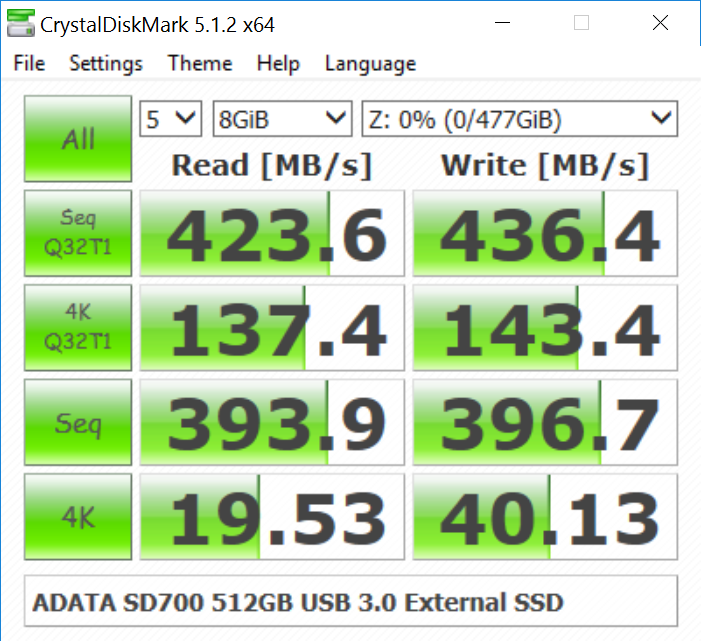
Our testing methodology for DAS units also takes into consideration the usual use-case for such devices. The most common usage scenario is transfer of large amounts of photos and videos to and from the unit. The minor usage scenario is importing files directly off the DAS into a multimedia editing program such as Adobe Photoshop.
In order to tackle the first use-case, we created three test folders with the following characteristics:
- Photos: 15.6 GB collection of 4320 photos (RAW as well as JPEGs) in 61 sub-folders
- Videos: 16.1 GB collection of 244 videos (MP4 as well as MOVs) in 6 sub-folders
- BR: 10.7 GB Blu-ray folder structure of the IDT Benchmark Blu-ray (the same that we use in our robocopy tests for NAS systems)





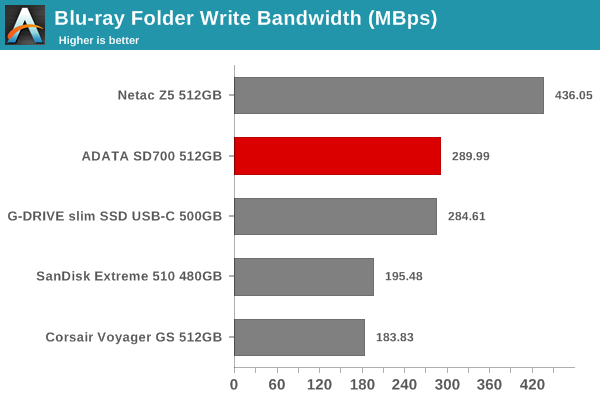
For the second use-case, we take advantage of PC Mark 8's storage bench. The storage workload involves games as well as multimedia editing applications. The command line version allows us to cherry-pick storage traces to run on a target drive. We chose the following traces.
- Adobe Photoshop (Light)
- Adobe Photoshop (Heavy)
- Adobe After Effects
- Adobe Illustrator
Usually, PC Mark 8 reports time to complete the trace, but the detailed log report has the read and write bandwidth figures which we present in our performance graphs. Note that the bandwidth number reported in the results don't involve idle time compression. Results might appear low, but that is part of the workload characteristic. Note that the same testbed is being used for all DAS units. Therefore, comparing the numbers for each trace should be possible across different DAS units.


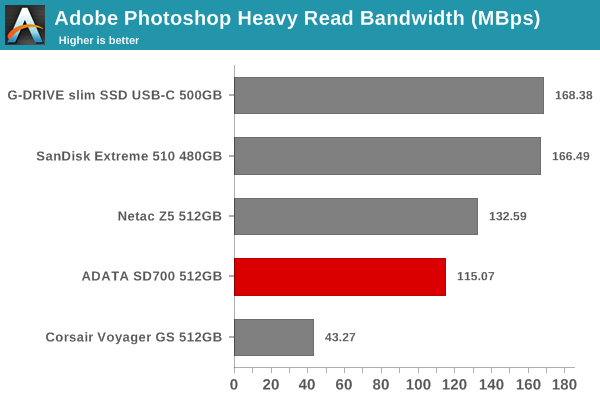


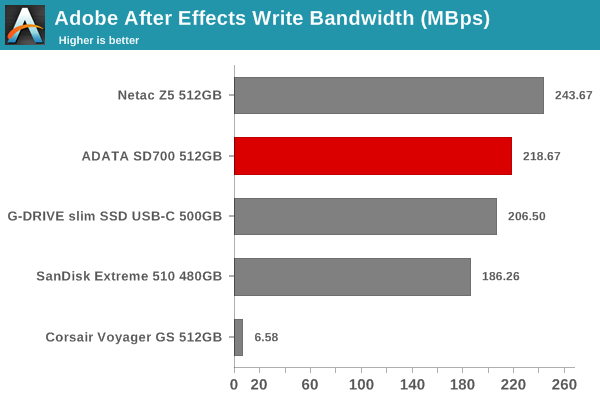
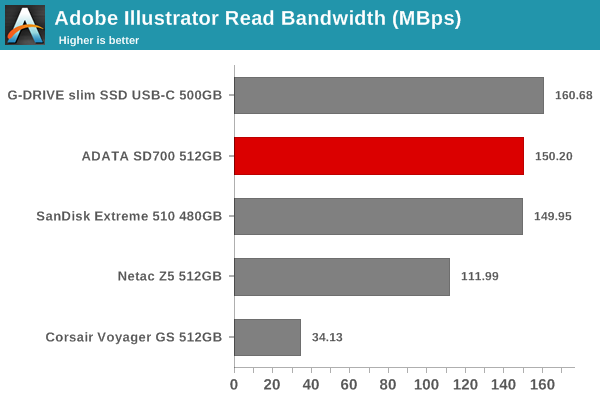

Performance Consistency
Yet another interesting aspect of these types of units is performance consistency. Aspects that may influence this include thermal throttling and firmware caps on access rates to avoid overheating or other similar scenarios. This aspect is an important one, as the last thing that users want to see when copying over, say, 100 GB of data to the flash drive, is the transfer rate going to USB 2.0 speeds. In order to identify whether the drive under test suffers from this problem, we instrumented our robocopy DAS benchmark suite to record the flash drive's read and write transfer rates while the robocopy process took place in the background. For supported drives, we also recorded the internal temperature of the drive during the process. The graphs below show the speeds observed during our real-world DAS suite processing. The first three sets of writes and reads correspond to the photos suite. A small gap (for the transfer of the videos suite from the primary drive to the RAM drive) is followed by three sets for the next data set. Another small RAM-drive transfer gap is followed by three sets for the Blu-ray folder.
An important point to note here is that each of the first three blue and green areas correspond to 15.6 GB of writes and reads respectively. Throttling, if any, is apparent within the processing of the photos suite itself.
ADATA SD700 512GBCorsair Voyager GS 512GBG-DRIVE slim SSD USB-C 500GBNetac Z5 512GBSanDisk Extreme 510 480GBDespite getting quite hot in our performance consistency test (more than 70C), the drive doesn't throttle. Thermal issues are definitely a concern in all water / dust-proof external SSDs, and the ADATA SD700 is no different. Consumers would do well to not subject sealed SSDs (such as this one and the SanDisk Extreme 510) to extremely heavy workloads.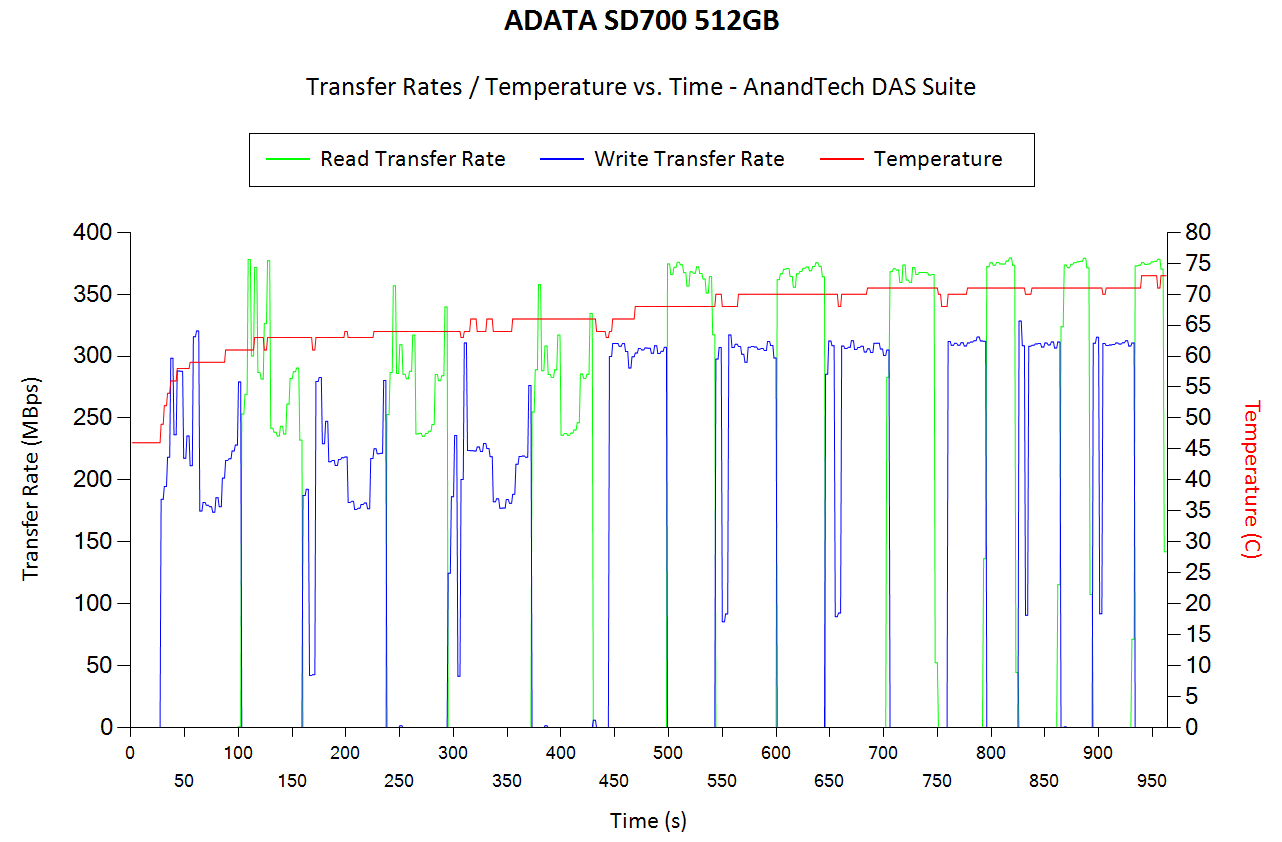
Concluding Remarks
The SD700 continues ADATA's tradition of bring external SSDs with good value for money to the market. As icing on the cake, the SD700 carries an IP68 rating also.
The performance of the drive leaves us with no doubt that it would be a great portable OS drive, even though ADATA doesn't advertise it for that purpose. After all, we have a real SSD inside - the Ultimate SU800. The JMicron bridge chip is also able to map the SCSI Unmap commands to TRIM, as our little test below shows.
Moving on to the pricing, the SD700 comes in at $209. In terms of cost per GB, we find that ADATA is beat only by G-Technology / SanDisk / Western Digital, which has its own flash manufacturing facility.
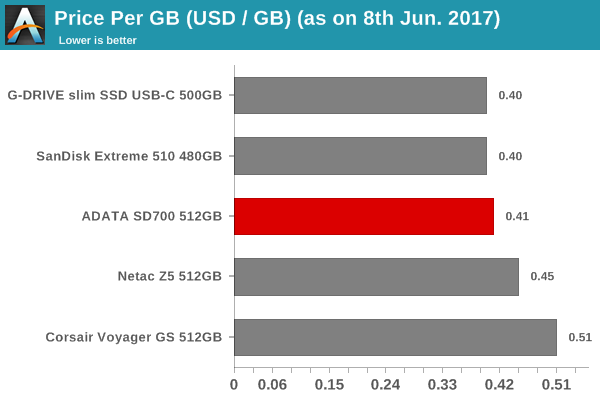
It is difficult to source IP68-rated enclosures into which one can put their own 2.5" drive. Therefore, going the DIY route to create a compact product like the ADATA SD700 with all its features is not going to be a feasible solution for the product's target market. ?ADATA must be given credit for being one of the first companies to bring 3D NAND to consumers in a IP68-rated product.
More...
-
06-08-17, 10:47 AM #7067
Anandtech: Nixeus NX-EDG 27 27-inch Gaming Monitor: 1440p, 30-144Hz FreeSync
Nixeus, a Los Angeles-based consumer electronics company that was founded in 2010, has officially launched their new EDG 27 gaming monitor, which they claim is the world’s first WQHD IPS-based display with an AMD FreeSync range of 30Hz to 144Hz.
Since the devil is in the details, their claim might indeed be correct. Based on our research, its principal competition either has a similar wide adaptive refresh range but a TN panel (Acer Predator XG270HU) or a 144Hz IPS panel that only supports a much narrower 35-90Hz FreeSync range (ASUS MG279Q). As a result, the Nixeus EDG 27 does indeed appear to be the only 144Hz FreeSync IPS monitor that has a 30Hz minimum refresh rate.
Focusing on some of the other specs, the Nixeus EDG 27 is a 27-inch model with a WQHD resolution of 2560 × 1440 and 16:9 aspect ratio. It features an IPS (AHVA) panel with a typical brightness of 300 cd/m2, a native contrast ratio of 1000:1, and a low 4ms gray-to-gray (GTG) response time. This a true 8-bit panel that can display 16.7 million colors, but there is no color gamut coverage details. The viewing angles are wide at 178°/178°, which is typical for an IPS display.
Connectivity appears excellent with multiple inputs, namely DisplayPort 1.2a, HDMI 2.0, HDMI 1.4, and Dual-Link DVI. The FreeSync feature is only supported on the DisplayPort, but the HDMI 2.0 can handle the full 2560 x 1440 resolution at 144Hz. There is no integrated USB hub, but there are built-in stereo speakers, and both input and output 3.5mm audio jacks.
The stand was designed with ergonomics in mind, and there is height adjustment, left and right swivel, forward and back tilt, and it even pivots 90-degrees for portrait mode. Cable management features have also been integrated into the stand, while the back of the display features a 100mm x 100mm VESA mount.
Backed by a 3-year manufacturer warranty, this model should start shipping sometime next month and it will retail for about $499 USD.Nixeus NX-EDG27 Panel 27-inch IPS (AHVA) Native Resolution 2560 x 1440 (16:9) Maximum Refresh Rate 144 Hz Dynamic Refresh Rate AMD FreeSync (30 Hz - 144 Hz) Response Time 4 ms (GTG) Brightness 300 cd/m2 Contrast 1000:1 Viewing Angles 178º/178º Pixel Density 109 PPI Display Colors 16.7 million Stand Pivot (-90º to 90º)
Tilt
Swivel
HeightInputs 1 x DisplayPort 1.2a
1 x Dual-Link DVI-D
1 x HDMI 2.0
1 x HDMI 1.4Audio Stereo Speakers
3.5mm Audio Output
3.5mm Audio Input
More...
-
06-08-17, 12:12 PM #7068
Anandtech: Cooler Master Shows Concept Coolers: Closed-Loop Heat Pipe and Flying Sauc
Hardware manufacturers use trade shows not only to display upcoming commercial products, but also to demonstrate and collect feedback on concept devices that may or may not become full commercial products. Cooler Master used Computex to demo two of its concept coolers, one of which featured a closed-loop heat pipe along with three fans, another used a large heat column and a rather unarthodox design.
Although many performance enthusiasts nowadays choose all-in-one liquid cooling solutions over air coolers because of dimensions and efficiency, oversized CPU tower coolers still have their own advantages: there is no risk of leaking, they are large and therefore they can cool down chips even if their fans fail, they are rather affordable too.
The MasterAir Maker 3DLV is one of Cooler Master’s concept coolers. It has two large radiators connected together using four closed-loop heat pipes and featuring three 120-mm fans. The main idea of heat pipes is to quickly transfer heat from the bottom of the cooler to fins located along the path of the pipes, away from the heat source. Closed-loop heat pipes have been explored by multiple companies and Zalman’s CNPS 9000-series coolers actually take advantage of them. The CNPS 9000's are round and the closed-loop heat pipes actually transferred heat to all fins. Meanwhile, CM’s 3DLV concept cooler is rectangular and does not have any fins on its top, just bare pipes and we have no idea how efficient such a configuration is. Still, three fans should ensure rather high efficiency anyway and the manufacturer promises that the cooler can remove up to 200 W of hear.
In the meantime it is unclear whether Cooler Master will actually commercialize this model, as due to its large dimensions it is not compatible with high-end memory modules that have large heatspreaders.
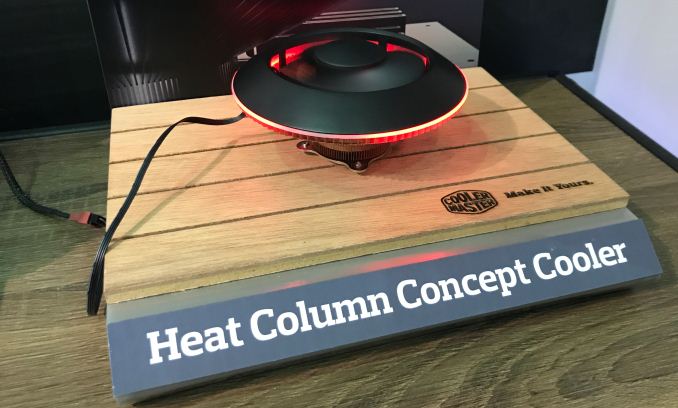
Meanwhile the Heat Column Concept is another cooler that CM demonstrated at Computex. This cooler resembled a flying saucer and featured a huge heat column on its base. The flying saucer cooler is made of copper and therefore quickly absorbs heat. The producer rates the device at 100 W TDP, which means that it can cool down all mainstream CPUs in the AM4 and LGA1151 form-factors from both manufacturers.
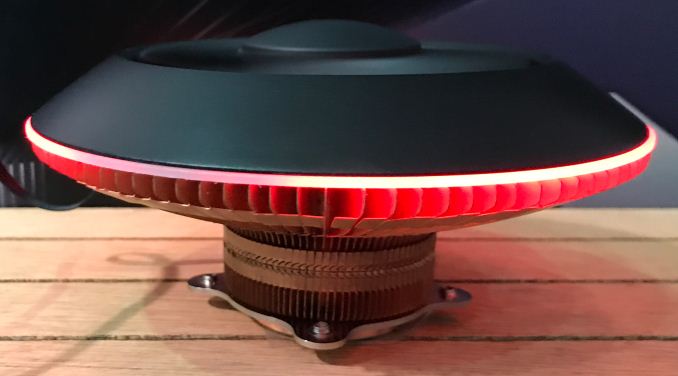
Cooler Master has not decided the final specs of the cooling solution or how to position it yet. One of the things the company’s engineers are thinking about are dimensions: they could make the “saucer” smaller and position it for, say, Mini-ITX system, or make it larger and then appeal to overclockers/modding community.
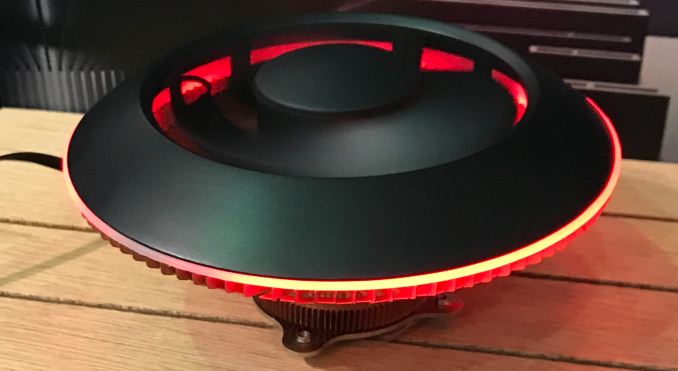
One of the things that the triple fan and the saucer coolers integrate is user-configurable RGB LED lighting, which is becoming an important feature. Because enthusiasts appreciate customizable lighting, it makes sense for Cooler Master to offer it not only with new cases, but also with CPU coolers.
Related Reading:
- Scythe Announces Mugen 5 CPU Cooler: New Design, Fan and Mounting
- The 140mm Slim Tower CPU Cooler Roundup: Thin & Light Done Just Right
- Top Tier CPU Air Coolers Q3 2015: 9-Way Roundup Review
- Battle of The CPU Stock Coolers! 7x Intel vs 5x AMD, plus an EVO 212
- Alpenföhn Unveils Olymp: A Giant Air Cooler Rated for 340W TDP
- CPU Air Cooler Roundup: Six Coolers from Noctua, SilverStone, be quiet!, and Cooler Master
More...
-
06-09-17, 08:17 AM #7069
Anandtech: The SilverStone Argon AR07 Cooler Review: Tower Cooling on a Budget
In today's review we are taking a look at the SilverStone Argon AR07 cooler. It is a large tower cooler that is making use of a 140 mm cooling fan, much like the advanced tower coolers that we recently reviewed. Although this particular cooler also requires the user to have a rather wide case, SilverStone’s approach is a little simpler and considerably cheaper, with the Argon AR07 retailing for $35 including shipping. In the following pages we will examine its build quality, practicality, and overall performance in comparison to both more advanced/expensive offering and one of its primary rivals in the market, the Cooler Master EVO 212.
More...
-
06-09-17, 08:17 AM #7070
Anandtech: AMD Releases Radeon Software ReLive Crimson Edition 17.6.1: Improved Perfo
Summer approaches and big budget games releases are slowing to a trickle. More importantly, school is closing meaning more gaming time for those not yet entrenched in the workforce. With Radeon Software Crimson ReLive Edition 17.6.1, including Driver Version 17.10.3211 (Windows Driver Store Version 22.19.171.1) AMD has prepared to improve experiences with a collection of fixes to smooth over bumps and stutters, and improved support for Dirt 4 and Prey.
With some of these fixes it seems AMD is preparing to push some more pixels. Users should now be able to once again enable Virtual Super Resolution, which was failing on some Radeon RX 400 and Radeon RX 500 series cards. HDR will now enable on more QHD HDR and higher monitors. There were also some flickering issues when using high refresh QHD monitors with an HDMI cable. Meanwhile systems with AMD XConnect and Modern Standby enabled should no longer experience a system hang after resuming from hibernation. And for Multi GPU systems performance is now improved in Prey for moments with fast mouse movement, and in Mass Effect Andromeda for general gameplay, meaning less hitching and stuttering during gameplay for both titles.
As for individual game support, this time around we have improved support for Dirt 4 and Prey. In Dirt 4 we now have a Multi GPU profile and up to 30% improved performance, though it should be noted that AMD measured this on a Radeon RX 580 at 4K (with the improvement being from 18.8FPS to 24.5 FPS), so it looks very much like an edge case for being GPU-bound. Moving on, Prey got initial support last month but this time gets an additional 4% improvement at 1440p on an RX 580, this time from 58.5FPS to 60.9 FPS. Less of an improvement than measured in Dirt 4, but more meaningful for being at framerates gamers will play at.
As always, those interested in reading more or installing the updated hotfix drivers for AMD’s desktop, mobile, and integrated GPUs can find them either under the driver update section in Radeon Settings or on AMDs Radeon Software Crimson ReLive Edition download page.
More...
Thread Information
Users Browsing this Thread
There are currently 19 users browsing this thread. (0 members and 19 guests)




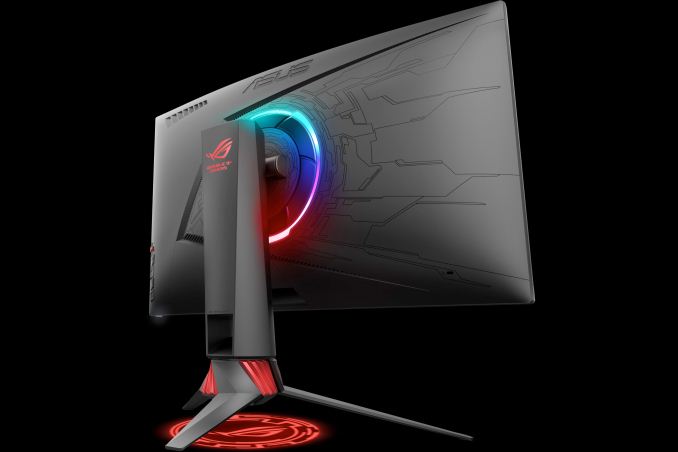
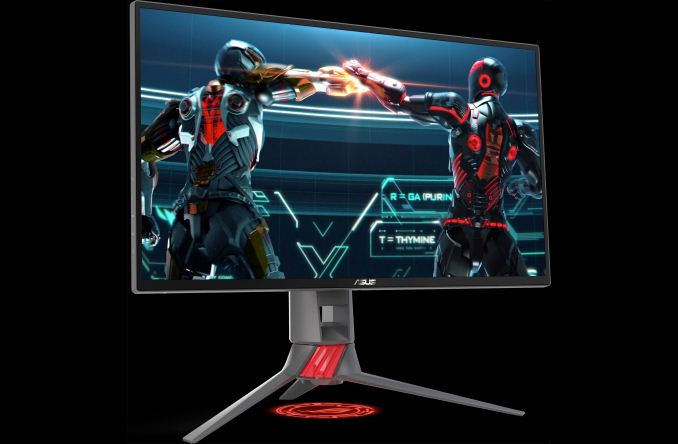

 Quote
Quote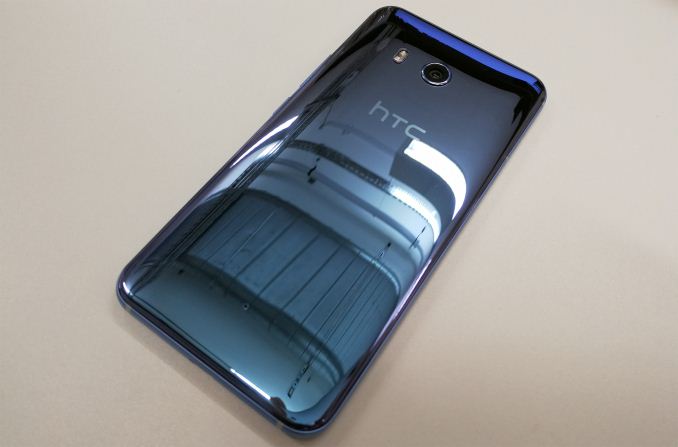
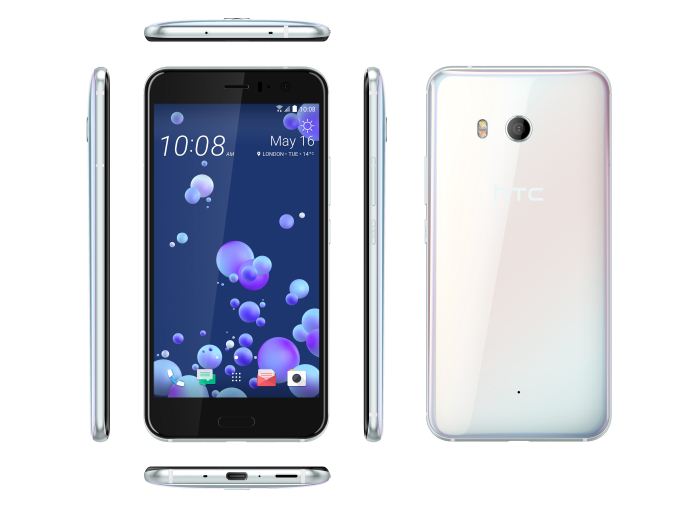
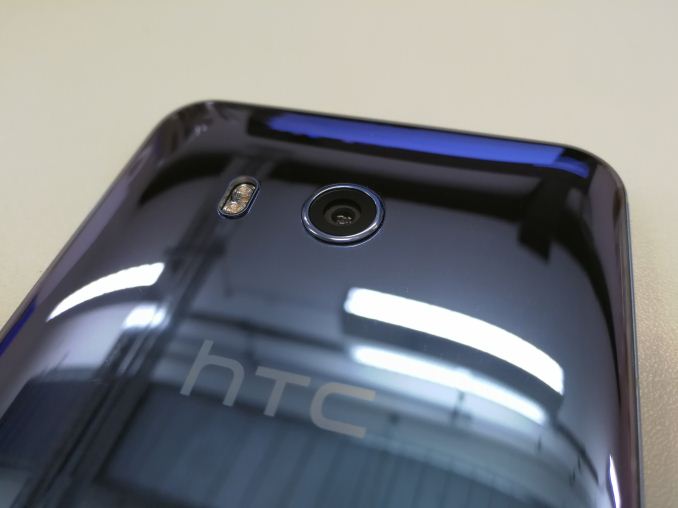
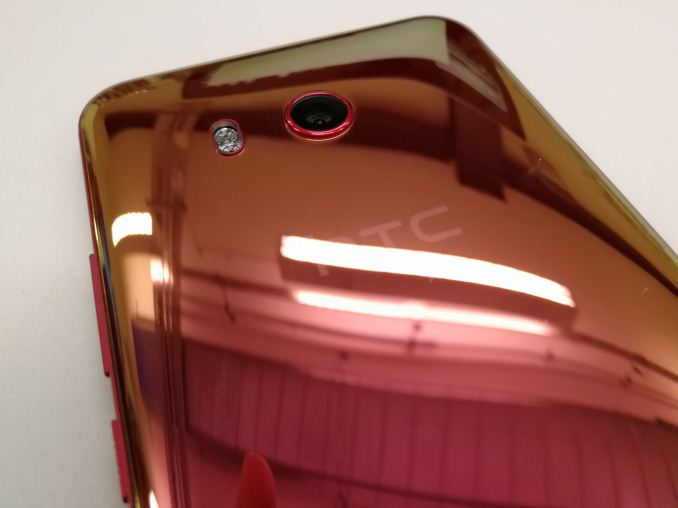

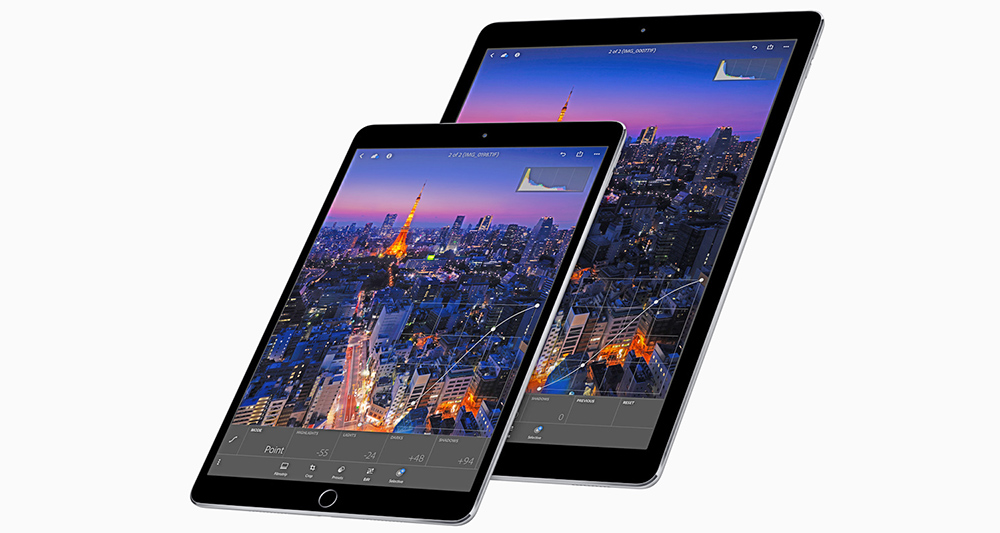

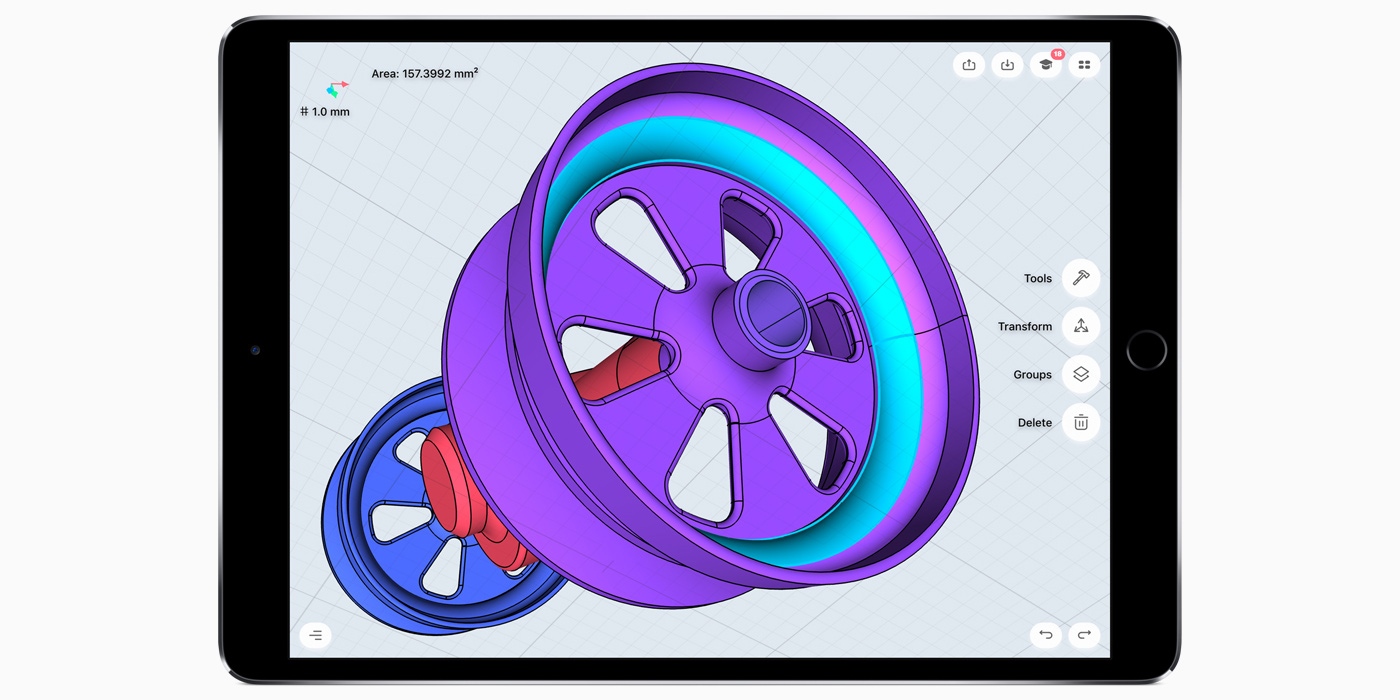
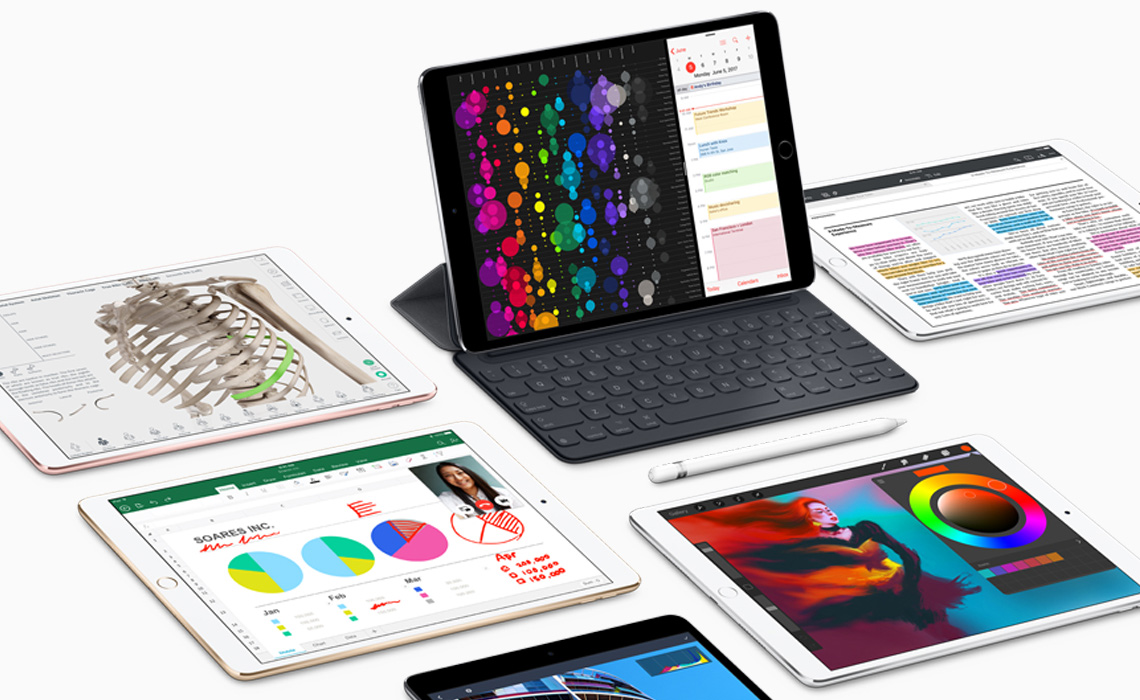
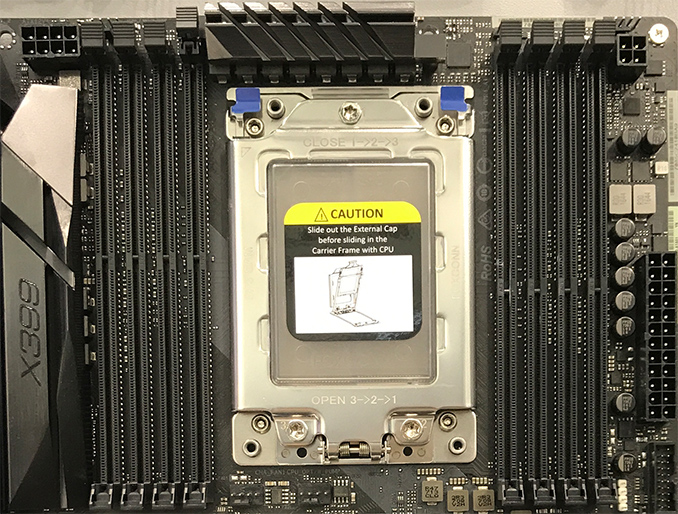
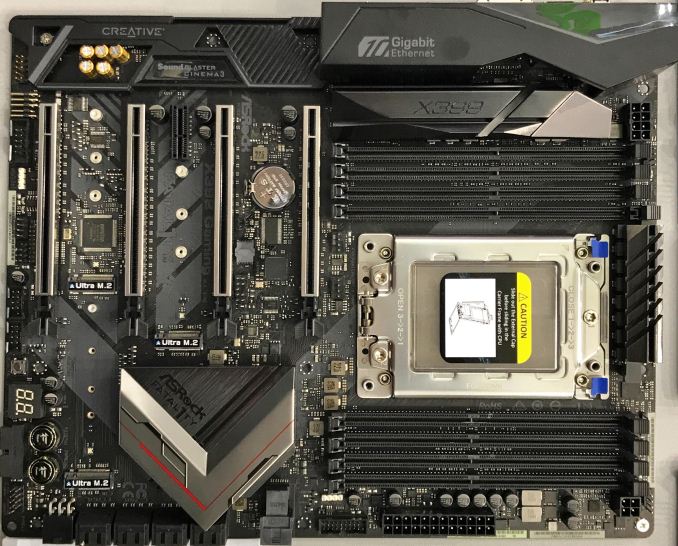
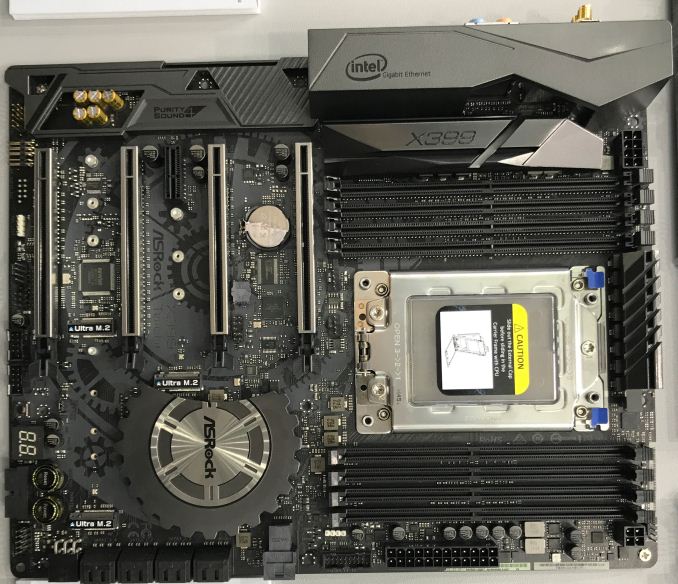
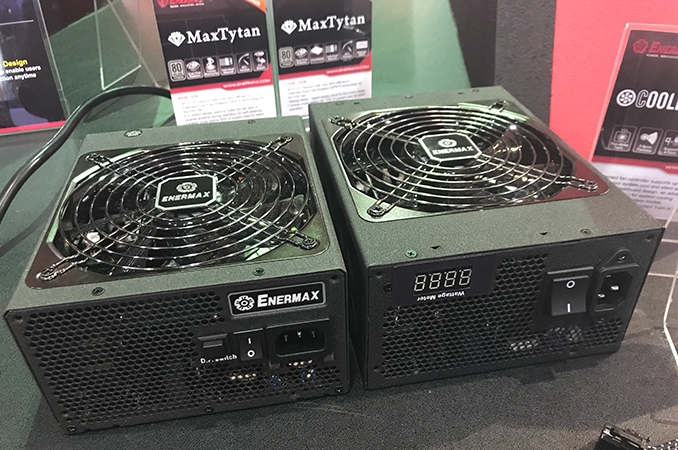











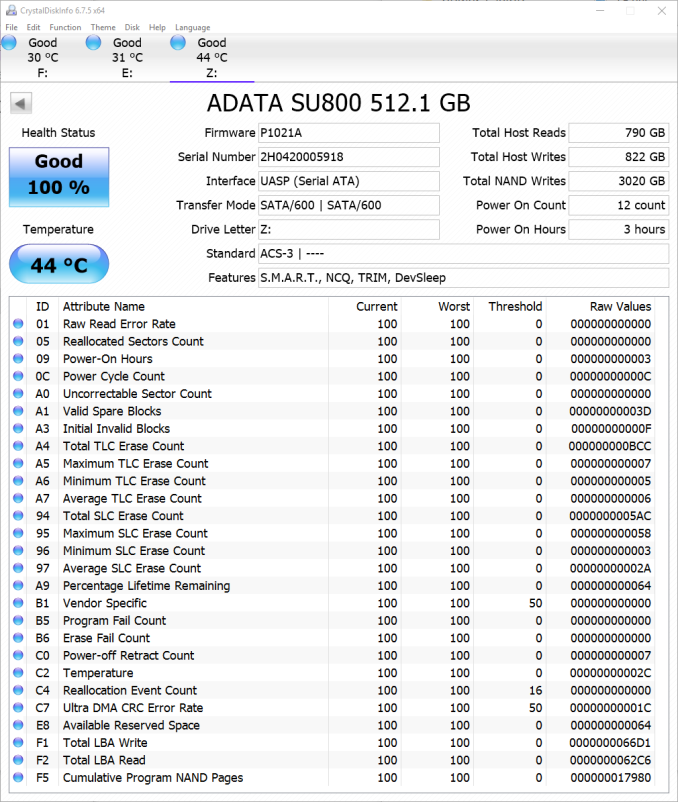
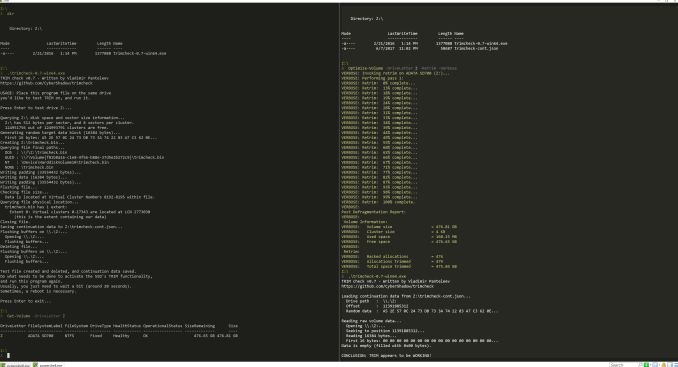





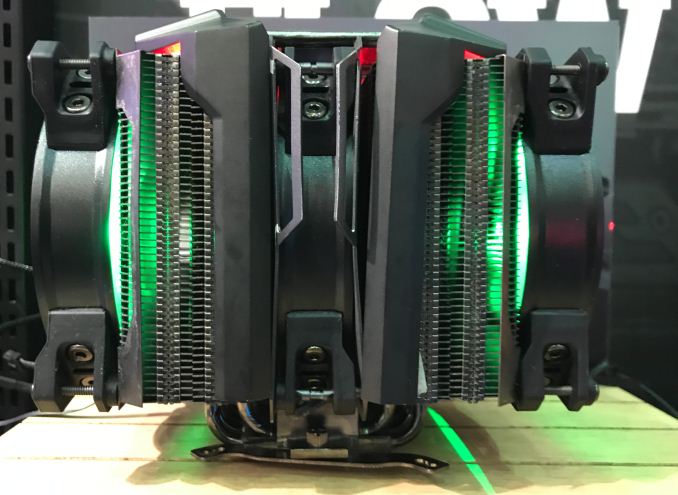
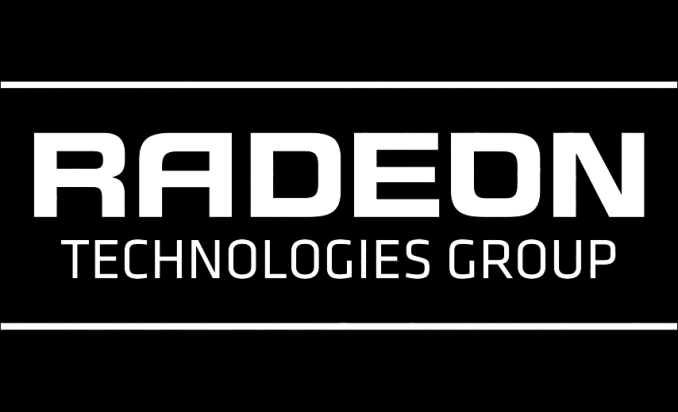
















Bookmarks